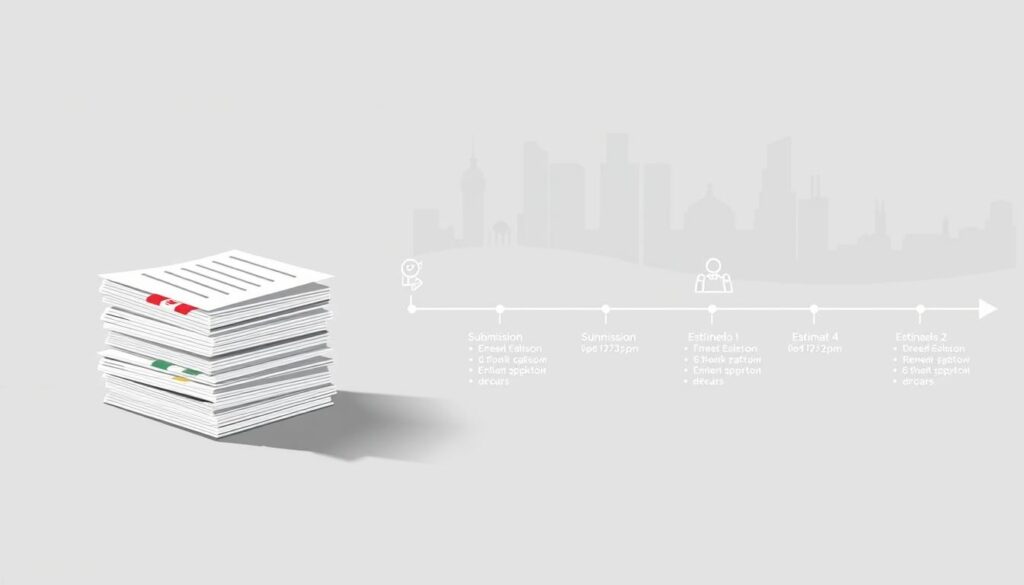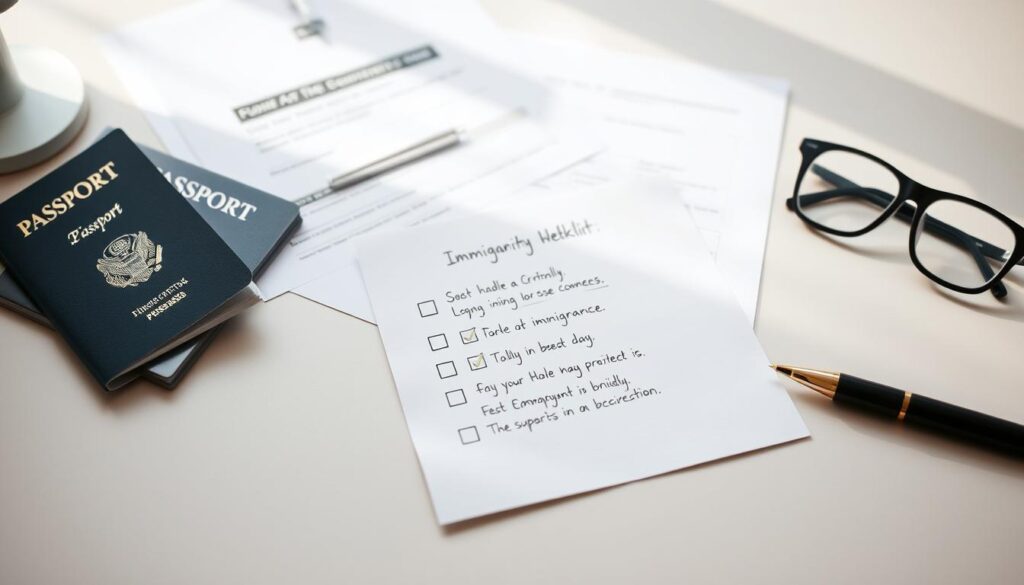Did you know that nearly 23% of permanent residents risk losing travel privileges because they delay renewing their status? With processing times stretching up to four months, timing is critical to avoid disruptions in work, healthcare, or family plans.
Your permanent resident card isn’t just a piece of plastic—it’s your official proof of legal status. Letting it expire could mean losing access to essential services or facing hurdles when re-entering the country. Fortunately, government portals now simplify submissions, letting you track progress and upload documents digitally.
To qualify, you must meet residency obligations: 730 days physically present within the last five years. Gathering paperwork like tax filings or travel records early helps avoid delays. Submitting six months before expiration ensures ample time to resolve unexpected issues.
Key Takeaways
- Start the renewal process at least six months before your card expires.
- Meet the 730-day residency requirement within the past five years.
- Use online government portals for faster submissions and updates.
- Prepare documents like tax records and proof of residence in advance.
- Processing typically takes 68–120 days, with a $50 fee as of 2025.
- Attention to detail reduces delays and ensures uninterrupted status.
Overview: The Importance of Renewing Your PR Card in Canada
A valid permanent resident card is your lifeline to essential services and rights. Letting it lapse could disrupt healthcare access, job opportunities, or even family reunification plans. Staying proactive helps you avoid these pitfalls while demonstrating compliance with residency rules.
What Renewal Means for Your Residency
Updating your card isn’t just paperwork—it’s proof you’ve met the 730-day physical presence rule. Authorities use this process to confirm you’re upholding residency obligations. Delays might trigger reviews, putting your status at risk.
An expired document complicates routine tasks like opening bank accounts or applying for loans. Employers and government agencies often require current proof of legal standing. Regular renewal keeps these doors open.
Maintaining Your Travel Privileges
Boarding flights to return home requires a valid card. If yours expires mid-trip, you’ll need a Permanent Resident Travel Document—a time-sensitive process that adds stress. Airlines won’t let you board without proper documentation.
Track your renewal progress through official portals to plan trips confidently. These platforms provide real-time updates, reducing uncertainty. Remember: even approved applications take weeks to arrive by mail.
Eligibility and Residency Requirements
Understanding your eligibility is the first step in maintaining your status. The process hinges on two critical factors: confirming your legal standing and meeting strict physical presence rules. Tools like the official visa portal simplify tracking your residency days and verifying qualifications.

Permanent Resident Status Requirements
Your status must remain active and unchallenged. This means you haven’t acquired citizenship or faced removal orders. Authorities verify this during renewal to ensure compliance with immigration laws.
Exceptions exist for those abroad with a citizen spouse or working for qualifying businesses. These cases require detailed paperwork to prove eligibility. Always consult official guidelines before assuming exceptions apply.
Meeting the 730-Day Physical Presence Obligation
The 730-day rule counts every hour spent within the country over five years. Work, study, and family time all contribute—but trips abroad don’t, even for valid reasons. Use entry/exit records or utility bills to build your timeline.
Missing the threshold? Gather evidence like employment contracts or medical records showing strong ties. Partial compliance may still qualify under humanitarian grounds, though approvals are rare.
Understanding the canada pr renewal application Process
Navigating the renewal process requires precision and timely action. The structured seven-step approach ensures you meet all legal requirements while minimizing delays. Start by accessing the official visa portal to download Form IMM 5444 and review document checklists.
Step-by-Step Process for Application
Begin with gathering proof of residency, such as tax filings or lease agreements. Calculate your physical presence days using entry/exit records or utility bills. Submit the completed form alongside supporting documents through the online portal or by mail.

After submission, schedule biometrics if required. Track your case status using the portal’s real-time updates. Missing a step could reset the clock, so double-check each requirement before proceeding.
Processing Times and What to Expect
Most cases take 68–120 days, but incomplete paperwork or high volumes can extend this timeframe. The review involves three phases: document verification, biometrics matching, and final approval. Avoid last-minute travel plans until you receive confirmation.
Delays often occur when residency proofs lack dates or signatures. Respond promptly if officers request additional details. Regular portal checks help you stay ahead of deadlines and maintain uninterrupted status.
Documents Needed for a Smooth Application
Submitting the right paperwork transforms complex processes into straightforward steps. Missing or incorrect items account for 41% of delayed cases, according to recent immigration data. Start by reviewing the official visa portal’s checklist to align your materials with current standards.

Mandatory Forms and Photographs
The IMM 5444 form acts as your primary request for status confirmation. Every field—from personal details to residency history—must match your supporting evidence. Signatures and dates require extra attention to avoid automatic rejections.
Two photos meeting IRCC guidelines ensure facial recognition systems work properly. Studios familiar with immigration standards typically provide compliant images. Avoid shadows, glasses, or non-neutral expressions.
Supporting Documents to Prove Your Residency
Build a five-year timeline using tax filings, pay stubs, and lease agreements. Financial records like bank statements show consistent activity within the country. Combine these with health insurance papers or academic enrollment confirmations for stronger proof.
| Document Type | Purpose | Examples |
|---|---|---|
| Application Form | Formal renewal request | IMM 5444 |
| Photographs | Identity verification | 50x70mm, white background |
| Financial Proof | Economic ties | Bank statements, tax assessments |
| Employment Records | Professional activity | T4 slips, employer letters |
| Housing Docs | Residential presence | Leases, utility bills |
Organize materials chronologically to help officers verify your presence efficiently. Digital copies should have clear scans without cropped edges or blurry text. Cross-reference each piece with the portal’s requirements before submission.
Completing and Submitting Your Application
Choosing the right submission method can mean the difference between approval in weeks versus months. Modern systems offer multiple pathways tailored to different needs—whether you prioritize speed, convenience, or personal assistance.

Online Submission Process via IRCC Portal
The digital portal remains the fastest method to submit your card renewal application. After creating an account, you’ll upload scanned documents meeting specific criteria:
- PDF or JPEG files under 4MB
- High-resolution copies showing full text
- Dated signatures within the last 90 days
Real-time tracking lets you monitor each stage—from initial review to final decision. Immediate confirmation emails eliminate guesswork about whether materials arrived safely.
Mail and In-Person Submission Options
Paper applications sent to Nova Scotia’s processing center take 3-6 weeks longer than online submissions. Use registered mail with tracking to prevent lost packages. Include a return envelope with your address clearly printed.
Service Canada locations provide face-to-face support for complex cases. Staff verify document completeness during appointments, reducing errors that cause delays. Bring originals and two copies of every item for quick cross-referencing.
| Method | Speed | Best For |
|---|---|---|
| Online Portal | 2-3 months | Tech-savvy applicants |
| 4-5 months | Paper-based systems | |
| In-Person | 2-3 months | Complex documentation |
Each approach requires precise fee payments—online portals accept credit cards, while mailed applications need certified checks. Double-check currency amounts and recipient details to prevent processing halts.
Biometrics, Fees, and Additional Requirements
New security protocols now shape how you confirm your identity during status updates. Since 2025, most individuals must provide fingerprints and digital photos through designated centers. This step adds a layer of verification while streamlining processing.

Scheduling Your Biometrics Appointment
After submitting your request, you’ll receive an instruction letter within 14 days. Book your appointment within 30 days at one of 58 centers nationwide. Major cities like Toronto and Vancouver offer multiple locations for convenience.
The $50 CAD fee must be paid online before attending. Government portals accept credit cards or Interac® transfers, providing instant confirmation receipts. Include this proof with your submission to avoid delays.
Bring these items to your visit:
- Original passport or travel document
- Biometrics instruction letter
- Payment confirmation slip
Technicians capture fingerprints using electronic scanners and take photos against neutral backgrounds. The process takes under 30 minutes but plan extra time for security checks. Missed appointments may reset your timeline by 60+ days.
| City | Service Hours | Walk-Ins Accepted? |
|---|---|---|
| Montreal | Mon-Fri 8:30am-4pm | No |
| Calgary | Tue-Sat 9am-5pm | Yes (limited) |
| Halifax | Wed-Fri 10am-3pm | No |
Track your payment status and appointment details through secure online accounts. These systems flag missing documents early, letting you resolve issues before deadlines.
Common Pitfalls and How to Avoid Them
Even minor errors can derail your status confirmation process. Overlooking details like unsigned forms or mismatched dates leads to unnecessary delays. Government data shows incomplete submissions account for nearly half of all processing hold-ups.
Review official checklists on the visa portal before submitting. These resources clarify photo standards, residency proofs, and travel history formats. Proactive verification helps you sidestep common traps.
Ensuring Accuracy in Your Application
Every field matters. Cross-reference personal details with supporting documents like passports or employment letters. Discrepancies in names or dates trigger manual reviews that add weeks to processing.
Photographs demand strict compliance. Studios familiar with immigration standards ensure proper sizing and backgrounds. Rejected images often feature shadows or incorrect dimensions.
Preventing Delays with Complete Documentation
Missing evidence of physical presence remains a top refusal reason. Combine bank statements, lease agreements, and tax filings to build a clear residency timeline. Digital copies must show full pages without cropping.
| Error | Impact | Solution |
|---|---|---|
| Unsigned forms | Automatic return | Verify signatures |
| Incorrect photo size | Resubmission needed | Use certified studio |
| Partial travel history | Extended review | Attach entry/exit records |
| Expired card abroad | Travel restrictions | Apply for travel document |
If your card expires while outside the country, you’ll need a Permanent Resident Travel Document for re-entry. Submit this request through designated visa offices, providing updated residency proofs.
Conclusion
Securing your future starts with proactive steps today. Keeping your resident card valid protects your legal status and ensures uninterrupted access to essential services. Government portals simplify tracking submissions and receiving updates, putting control at your fingertips.
Begin the process at least six months before expiration to account for processing times. Organized documents like tax filings and lease agreements speed up verification. Digital tools help maintain accurate records for future needs.
Understanding requirements reduces errors that delay approvals. Professional guidance can clarify complex cases, while official resources offer reliable support. Staying informed empowers confident navigation through immigration processes.
Your resident status opens doors to long-term opportunities. Regular maintenance of your card safeguards your ability to work, travel, and build a life without interruptions.



